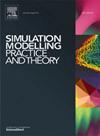Experimental and numerical modal analysis of an unmanned aerial vehicle's composite wing
IF 3.5
2区 计算机科学
Q2 COMPUTER SCIENCE, INTERDISCIPLINARY APPLICATIONS
引用次数: 0
Abstract
This paper investigates the structural dynamics of a UAV composite wing through FEM simulations and experimental modal analysis, aiming to replace traditional experimental testing in UAV structural evaluations. The simulations, performed with Ansys Composite Prep/Post (ACP), model each composite layer with specific fiber orientations, material properties, and thickness. Experimental tests, utilizing a shaker for excitation and an accelerometer for response measurement, were conducted on the aircraft in the frequency range of 0 to 1100 Hz, targeting operationally relevant harmonic frequencies. A comparative analysis between simulation and experimental results identifies sources of discrepancies, particularly in critical low-frequency modes essential for UAV performance. The study highlights how simplifications in the FEM model, such as excluding control surfaces and assuming material homogeneity, impact simulation accuracy. The paper concludes by outlining directions for further research, stressing the need to refine FEM models and enhance composite material representations to improve UAV reliability and simulation accuracy.
无人机复合材料机翼试验与数值模态分析
本文通过有限元模拟和实验模态分析对某型无人机复合材料机翼结构动力学进行了研究,旨在取代传统的无人机结构评估实验测试。利用Ansys Composite Prep/Post (ACP)软件进行的模拟,对每个复合材料层进行了特定纤维取向、材料性能和厚度的建模。实验测试利用激振器进行激励,利用加速度计进行响应测量,在0至1100 Hz的频率范围内对飞机进行了测试,目标是与运行相关的谐波频率。仿真和实验结果之间的比较分析确定了差异的来源,特别是在无人机性能必不可少的关键低频模式中。研究强调了有限元模型的简化,如排除控制面和假设材料均匀性,如何影响模拟精度。最后,提出了进一步研究的方向,强调需要完善有限元模型,增强复合材料表征,以提高无人机的可靠性和仿真精度。
本文章由计算机程序翻译,如有差异,请以英文原文为准。
求助全文
约1分钟内获得全文
求助全文
来源期刊

Simulation Modelling Practice and Theory
工程技术-计算机:跨学科应用
CiteScore
9.80
自引率
4.80%
发文量
142
审稿时长
21 days
期刊介绍:
The journal Simulation Modelling Practice and Theory provides a forum for original, high-quality papers dealing with any aspect of systems simulation and modelling.
The journal aims at being a reference and a powerful tool to all those professionally active and/or interested in the methods and applications of simulation. Submitted papers will be peer reviewed and must significantly contribute to modelling and simulation in general or use modelling and simulation in application areas.
Paper submission is solicited on:
• theoretical aspects of modelling and simulation including formal modelling, model-checking, random number generators, sensitivity analysis, variance reduction techniques, experimental design, meta-modelling, methods and algorithms for validation and verification, selection and comparison procedures etc.;
• methodology and application of modelling and simulation in any area, including computer systems, networks, real-time and embedded systems, mobile and intelligent agents, manufacturing and transportation systems, management, engineering, biomedical engineering, economics, ecology and environment, education, transaction handling, etc.;
• simulation languages and environments including those, specific to distributed computing, grid computing, high performance computers or computer networks, etc.;
• distributed and real-time simulation, simulation interoperability;
• tools for high performance computing simulation, including dedicated architectures and parallel computing.
 求助内容:
求助内容: 应助结果提醒方式:
应助结果提醒方式:


